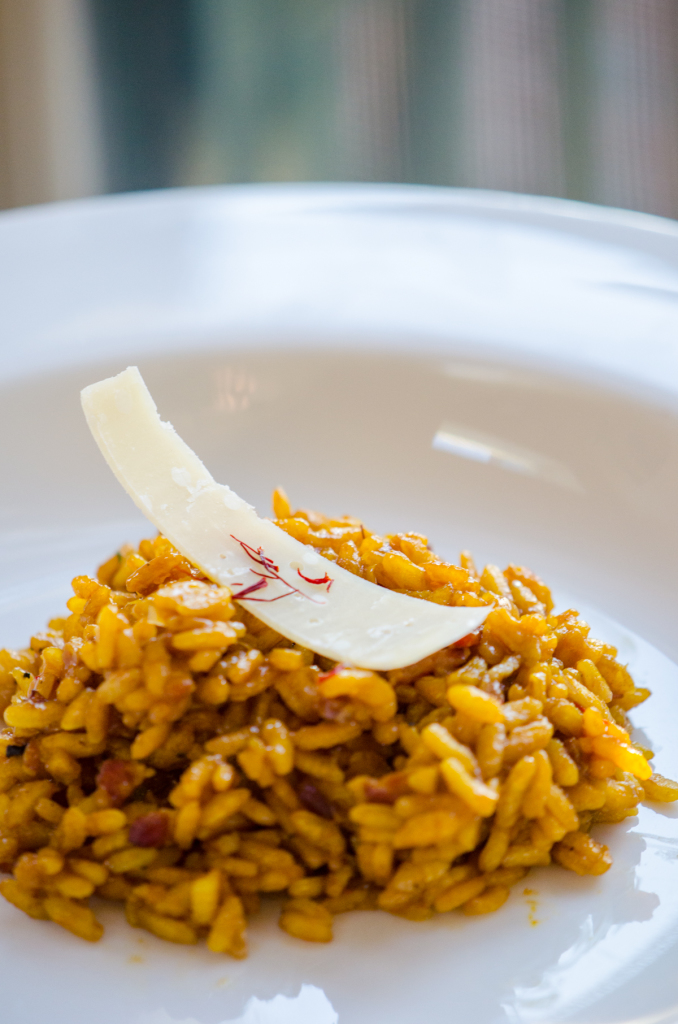 My last post was on the classic dish from Milan, Ossobuco alla Milanese. The obvious follow-on is its time-honored accompaniment, Risotto alla Milanese. Risotto dishes have graced the tables of Northeastern Italy for centuries, as the special plump short grained rice varietals grown in the Veneto, Lombardia and Emilia-Romagna are perfectly suited for this preparation. We enjoy tasting, and preparing, several risotto dishes on our private Italy tours. Risotto alla Milanese is one of the simplest preparations, with its distinctive color, aroma and flavor due to one essential ingredient – saffron.
My last post was on the classic dish from Milan, Ossobuco alla Milanese. The obvious follow-on is its time-honored accompaniment, Risotto alla Milanese. Risotto dishes have graced the tables of Northeastern Italy for centuries, as the special plump short grained rice varietals grown in the Veneto, Lombardia and Emilia-Romagna are perfectly suited for this preparation. We enjoy tasting, and preparing, several risotto dishes on our private Italy tours. Risotto alla Milanese is one of the simplest preparations, with its distinctive color, aroma and flavor due to one essential ingredient – saffron.
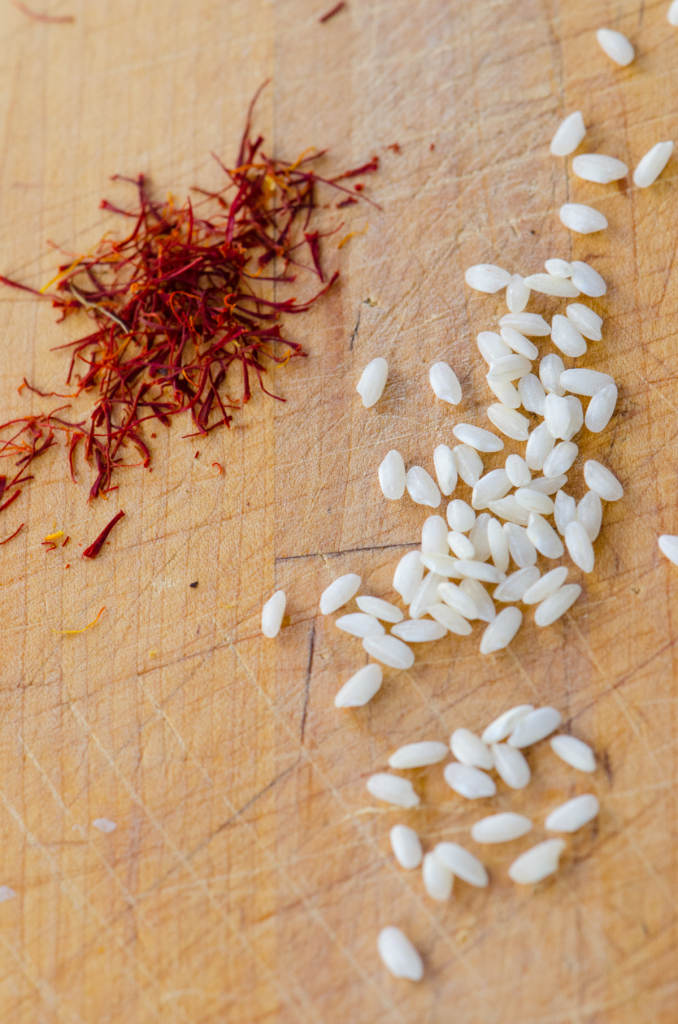 How this saffron flavored version became Milan’s favorite risotto is once again uncertain. Venetian Jews made a similar preparation simply called riso col zafran. The Jews and Arabs of medieval Sicily made a saffron pilaf, which may have been found its way to Milan with some of these Sicilians who traveled north. Waverly Root, in his classic book, The Food of Italy, reminds us that in 1535, Charles V of Spain named his son, Philip, Duke of Milan, beginning nearly two centuries of Spanish rule here. His theorizes that Risotto alla Milanese is a descendent of paella. He goes on to tell of a Milanese cook that was nicknamed Zafferano because of his widespread use of saffron; when he married the daughter of a master stained-glass maker in 1574, the “wedding feast was enlivened by joking friends who slipped saffron into every dish which could possibly stand it, and some which couldn’t.” Whatever the path, Risotto alla Milanese is today standard fare in trattorie across Milan.
How this saffron flavored version became Milan’s favorite risotto is once again uncertain. Venetian Jews made a similar preparation simply called riso col zafran. The Jews and Arabs of medieval Sicily made a saffron pilaf, which may have been found its way to Milan with some of these Sicilians who traveled north. Waverly Root, in his classic book, The Food of Italy, reminds us that in 1535, Charles V of Spain named his son, Philip, Duke of Milan, beginning nearly two centuries of Spanish rule here. His theorizes that Risotto alla Milanese is a descendent of paella. He goes on to tell of a Milanese cook that was nicknamed Zafferano because of his widespread use of saffron; when he married the daughter of a master stained-glass maker in 1574, the “wedding feast was enlivened by joking friends who slipped saffron into every dish which could possibly stand it, and some which couldn’t.” Whatever the path, Risotto alla Milanese is today standard fare in trattorie across Milan.
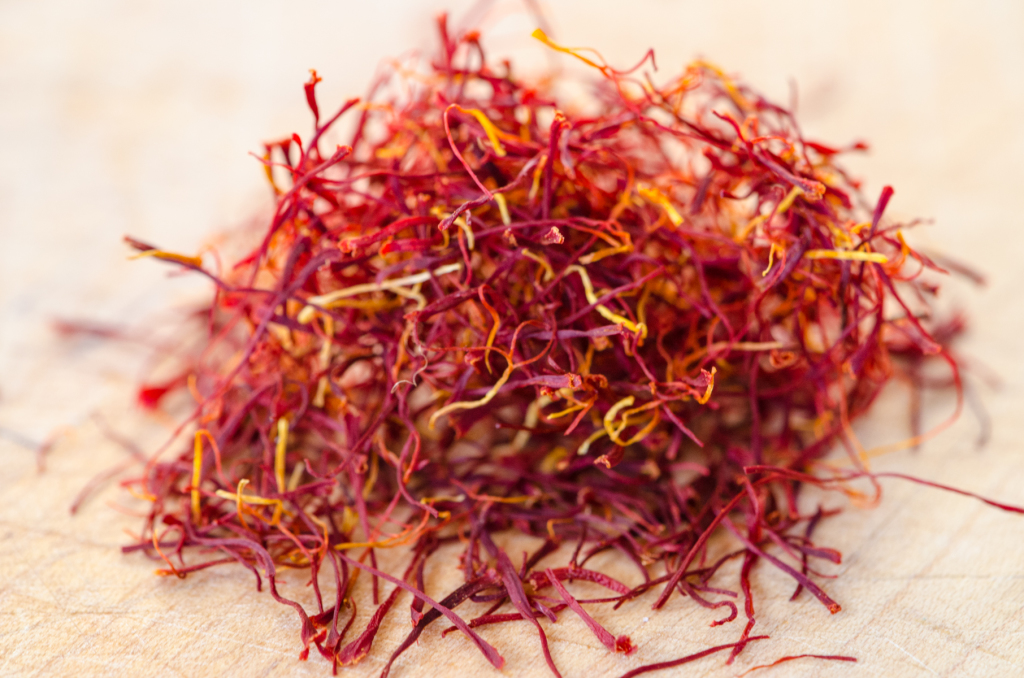 Saffron itself is the world’s most expensive spice; true, high quality saffron is the stigma, or threads attached to the pistil of the domesticated saffron crocus. Each flower produces only 3 pistils. The threads are carefully harvested and then dried, loosing between 60 and 80% of their weight in the process. It takes between 55,000 and 60,000 flowers to produce one pound of saffron.
Saffron itself is the world’s most expensive spice; true, high quality saffron is the stigma, or threads attached to the pistil of the domesticated saffron crocus. Each flower produces only 3 pistils. The threads are carefully harvested and then dried, loosing between 60 and 80% of their weight in the process. It takes between 55,000 and 60,000 flowers to produce one pound of saffron.
In the Middle Ages, saffron was cultivated in many areas in Italy, especially Tuscany. Known then as “red gold”, it was valued in the kitchen as well as used in medicines, perfumes and dyes. Fields of saffron crocuses covered the area around San Gimignano and elsewhere in Tuscany. Profits from the sale of this coveted spice helped build the famous towers of San Gimignano. Cheaper imported saffron from France eventually took over this market, and the fields in Tuscany were put to other use.
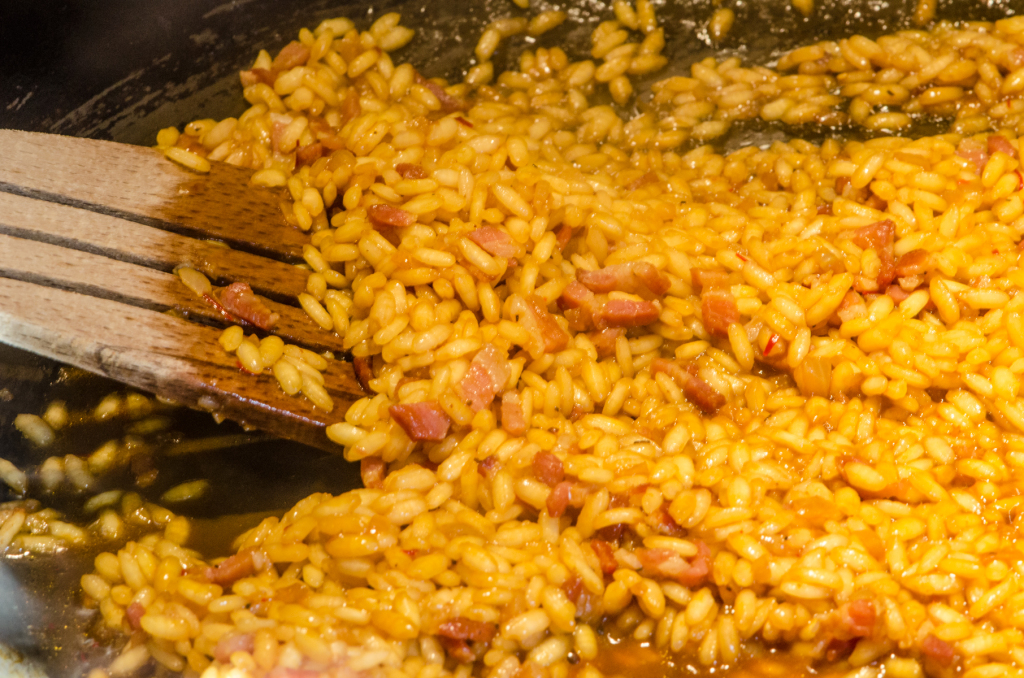 Today, the two areas in Italy still known for saffron production are in Abruzzo and Sardinia. Zafferano dell’Aquila, reputed to be the best saffron in the world, is grown exclusively on eight hectares in the Navelli Valley of Italy’s Abruzzo region, near L’Aquila. Here in the Navelli Valley, crocus bulbs are planted in August by a handful of local farmers. When the flowers blossom, sometime in October, they must be picked before dawn, while they are closed, so as not to lose any of the stigma’s powder during harvesting. The orange-red threads are removed by hand, then they are dried over a fire of neutral wood, to preserve the unique flavor of the saffron.
Today, the two areas in Italy still known for saffron production are in Abruzzo and Sardinia. Zafferano dell’Aquila, reputed to be the best saffron in the world, is grown exclusively on eight hectares in the Navelli Valley of Italy’s Abruzzo region, near L’Aquila. Here in the Navelli Valley, crocus bulbs are planted in August by a handful of local farmers. When the flowers blossom, sometime in October, they must be picked before dawn, while they are closed, so as not to lose any of the stigma’s powder during harvesting. The orange-red threads are removed by hand, then they are dried over a fire of neutral wood, to preserve the unique flavor of the saffron.
The largest saffron producer in Italy is San Gavino Monreale, Sardinia, which contributes 60% of Italy’s total production. There are a few small producers now beginning to reintroduce saffron cultivation to Tuscany. Do make sure to obtain a high quality saffron for this dish; only a little is needed. There are a lot of cheap imitations and powders on the market.
For a regional wine to pair with this, I would again recommend a Nebbiolo based red from the Valtellina DOC in Lombardy. Saffron goes well with reds as well as white. If you would prefer a white, a nice crisp one from Lugana would fit the bill.
Risotto alla Milanese – Risotto with Saffron
4 cups beef broth, either homemade or low sodium store bought
1 tablespoon butter
1 tablespoon extra virgin olive oil
1/4 cup diced pancetta
1/4 cup onion, finely diced
1 1/2 cups risotto rice – carnaroli, arborio or vialone nano
1/2 teaspoons chopped saffron strands
1/2 cup freshly ground parmigiano reggiano cheese
Place the beef broth in a medium saucepan and bring to a low simmer.
Combine the butter and oil in a heavy, large skilled over medium-high heat. Add the pancetta and onion and cook until the onion is soft and translucent, about 4-5 minutes. Stir in the rice to coat with the oil, and cook for 1 minute.
Add the broth, 1/2 cup at a time, stirring after each addition and waiting until the broth is absorbed by the rice before adding the next 1/2 cup. When you have incorporated about half of the broth, remove a 1/2 cup of the broth and dissolve the saffron strands in this warm stock. Add it to the risotto and continue to cook, adding stock as needed.
When the rice is tender, but still firm to the bite – al dente – turn off the heat. You do not need to use up all of the stock. Add in a last 1/4 cup of broth and stir in the grated cheese. Season with salt and pepper, and serve immediately.
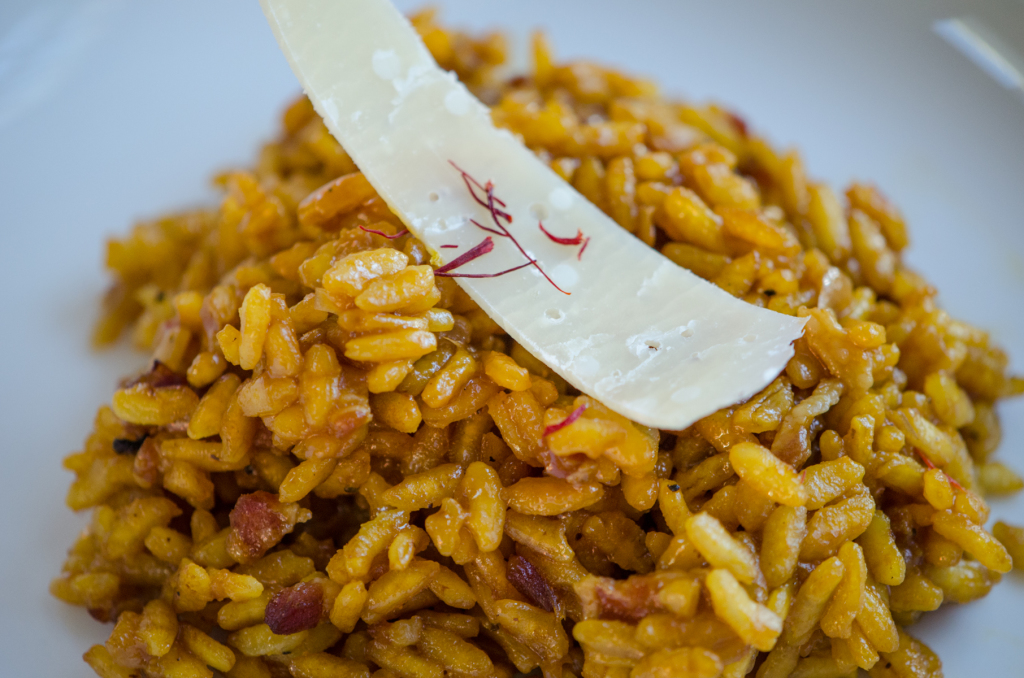

Pingback: Risotto Con Zucca E Salsiccia - Risotto With Pumpkin And Sausage | Italian Food, Wine, And Travel
Pingback: Risotto al Limone e Gamberetti - Risotto with Lemon and Shrimp | Italian Food, Wine, and Travel